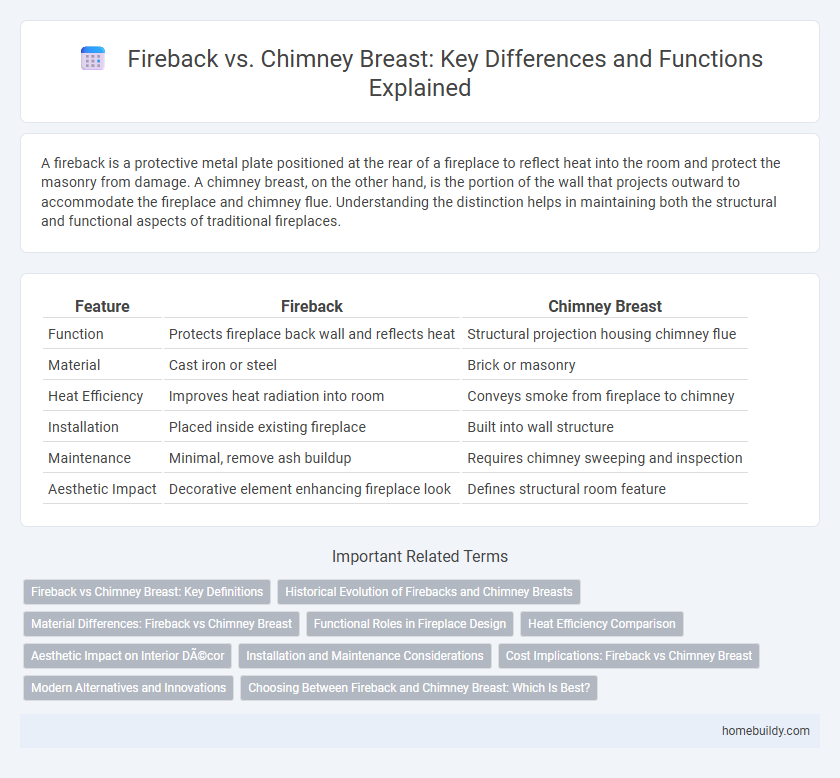A fireback is a protective metal plate positioned at the rear of a fireplace to reflect heat into the room and protect the masonry from damage. A chimney breast, on the other hand, is the portion of the wall that projects outward to accommodate the fireplace and chimney flue. Understanding the distinction helps in maintaining both the structural and functional aspects of traditional fireplaces.
Table of Comparison
| Feature | Fireback | Chimney Breast |
|---|---|---|
| Function | Protects fireplace back wall and reflects heat | Structural projection housing chimney flue |
| Material | Cast iron or steel | Brick or masonry |
| Heat Efficiency | Improves heat radiation into room | Conveys smoke from fireplace to chimney |
| Installation | Placed inside existing fireplace | Built into wall structure |
| Maintenance | Minimal, remove ash buildup | Requires chimney sweeping and inspection |
| Aesthetic Impact | Decorative element enhancing fireplace look | Defines structural room feature |
Fireback vs Chimney Breast: Key Definitions
A fireback is a cast iron plate positioned at the back of a fireplace to protect masonry and reflect heat into the room, enhancing warmth efficiency. A chimney breast refers to the vertical section of a wall that houses the chimney flue and supports the fireplace structure. Understanding the fireback's role in heat reflection contrasts with the chimney breast's function as a structural and ventilation element within a fireplace setup.
Historical Evolution of Firebacks and Chimney Breasts
Firebacks date back to the medieval period, designed to protect the masonry of open hearths from intense heat while reflecting warmth into the room, often featuring ornate cast iron artwork symbolizing status and craftsmanship. Chimney breasts evolved as structural projections in walls to accommodate the firebox and flue, becoming prominent during the Tudor and Elizabethan eras as fireplaces transitioned from purely functional to decorative elements. The interplay of firebacks and chimney breasts highlights advancements in heating technology and architectural aesthetics from the Middle Ages through the Georgian period.
Material Differences: Fireback vs Chimney Breast
Firebacks are typically made of cast iron designed to absorb and radiate heat efficiently, enhancing the fireplace's warmth and protecting the masonry. In contrast, chimney breasts are constructed from brick or stone, serving as structural components that channel smoke and gases safely out of the building. The material differences emphasize firebacks' heat retention properties versus chimney breasts' durability and support in ventilation systems.
Functional Roles in Fireplace Design
Firebacks serve as protective, heat-retaining elements placed at the back of fireplaces, reflecting heat into the room and safeguarding masonry from damage. Chimney breasts, structural protrusions housing the fireplace and chimney flue, primarily support the chimney system while enclosing the firebox. In fireplace design, firebacks optimize thermal efficiency and durability, whereas chimney breasts fulfill essential architectural and ventilation functions.
Heat Efficiency Comparison
A fireback significantly improves heat efficiency by reflecting radiant heat into the room, whereas a chimney breast mainly serves as a structural enclosure for the chimney with minimal impact on heat distribution. Firebacks, often made of cast iron, retain and radiate heat longer than the brick or stone surfaces of chimney breasts, enhancing overall room warmth. This results in more effective use of fuel and reduced energy costs compared to relying solely on the chimney breast's heat retention.
Aesthetic Impact on Interior Décor
Firebacks enhance the aesthetic impact of interior decor by adding warmth and historical charm to a room, often featuring intricate designs that complement traditional or rustic styles. In contrast, chimney breasts, while structurally essential, can dominate the space and limit design flexibility due to their bulk and plain surfaces. Opting for a decorative fireback allows for a focal point that balances practicality with artistic appeal, enriching the overall ambiance without overwhelming the interior layout.
Installation and Maintenance Considerations
Firebacks are easier to install as they fit directly against the fireplace wall, requiring minimal structural alterations compared to chimney breasts, which often necessitate extensive brickwork and professional expertise. Maintenance of firebacks is straightforward, involving periodic cleaning to prevent soot buildup and corrosion, whereas chimney breasts demand regular inspections for structural integrity and potential damp issues. Choosing firebacks reduces long-term upkeep costs and simplifies installation, making them a practical choice for enhancing fireplace efficiency.
Cost Implications: Fireback vs Chimney Breast
Firebacks generally cost less to install compared to chimney breasts due to simpler construction and smaller material requirements. Chimney breasts involve significant structural modifications and higher labor costs, especially in older buildings. Choosing a fireback can offer a cost-effective alternative for enhancing fireplace efficiency without extensive remodeling expenses.
Modern Alternatives and Innovations
Modern firebacks offer innovative materials like cast iron with heat-retentive properties, providing improved efficiency compared to traditional chimney breasts. Sleek designs incorporate heat shields and reflectors that maximize warmth distribution while minimizing smoke and soot buildup. Advanced insulation technologies in firebacks enhance safety and reduce heat loss, presenting a contemporary alternative for sustainable and effective fireplace heating solutions.
Choosing Between Fireback and Chimney Breast: Which Is Best?
Choosing between a fireback and a chimney breast depends on the fireplace's structural requirements and aesthetic preferences. Firebacks provide efficient heat reflection and protect the fireplace back wall, making them ideal for enhancing heat output in traditional fireplaces. Chimney breasts, integral to the building's structure, direct smoke upward and offer a classic architectural feature while requiring more space and installation effort.
Fireback vs Chimney Breast Infographic

 homebuildy.com
homebuildy.com